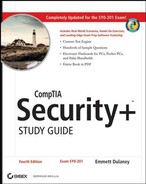8.8. Review Questions
Although you're talking to her on the phone, the sound of the administrative assistant's screams of despair can be heard down the hallway. She has inadvertently deleted a file that the boss desperately needs. Which type of backup is used for the immediate recovery of a lost file?
Onsite storage
Working copies
Incremental backup
Differential backup
Which system frequently has audit files/transaction logs that can be used for recovery?
Database system
Application server
Backup server
User system
You're trying to rearrange your backup procedures to reduce the amount of time they take each evening. You want the backups to finish as quickly as possible during the week. Which backup system backs up only the files that have changed since the last backup?
Full backup
Incremental backup
Differential backup
Backup server
Which backup system backs up all the files that have changed since the last full backup?
Full backup
Incremental backup
Differential backup
Archival backup
You're a consultant brought in to advise MTS on its backup procedures. One of the first problems you notice is that the company doesn't utilize a good tape-rotation scheme. Which backup method uses a rotating schedule of backup media to ensure long-term information storage?
Grandfather, Father, Son method
Full Archival method
Backup Server method
Differential Backup method
Which site best provides limited capabilities for the restoration of services in a disaster?
Hot site
Warm site
Cold site
Backup site
You're the head of information technology for MTS and have a brother in a similar position for ABC. Both companies are approximately the same size and are located several hundred miles apart. As a benefit to both companies, you want to implement an agreement that would allow either company to use resources at the other site should a disaster make a building unusable. What type of agreement between two organizations provides mutual use of their sites in the event of an emergency?
Backup-site agreement
Warm-site agreement
Hot-site agreement
Reciprocal agreement
The process of automatically switching from a malfunctioning system to another system is called what?
Fail safe
Redundancy
Fail-over
Hot site
You've been brought in as a temporary for FRS, Inc. The head of IT assigns you the task of evaluating all servers and their disks and making a list of any data not stored redundantly. Which disk technology isn't fault tolerant?
RAID 0
RAID 1
RAID 3
RAID 5
Which agreement outlines performance requirements for a vendor?
MTBF
MTTR
SLA
BCP
Your company is about to invest heavily in an application written by a new startup. Because it is such a sizable investment, you express your concerns about the longevity of the new company and the risk this organization is taking. You propose that the new company agree to store its source code for use by customers in the event that it ceases business. What is this model called?
Code escrow
SLA
BCP
CA
Which policy describes how computer systems may be used within an organization?
Due care policy
Acceptable-use policy
Need-to-know policy
Privacy policy
You're the administrator for STM and have been summoned to an unannounced audit. The auditor states that he is unable to find anything in writing regarding confidentiality of customer records. Which policy should you produce?
Separation-of-duties policy
Due care policy
Physical access policy
Document destruction policy
Which policy dictates how an organization manages certificates and certificate acceptance?
Certificate policy
Certificate access list
CA accreditation
CRL rule
You're giving hypothetical examples during a required security training session when the subject of certificates comes up. A member of the audience wants to know how a party is verified as genuine. Which party in a transaction is responsible for verifying the identity of a certificate holder?
Subscriber
Relying party
Third party
Omni registrar
Which of the following would normally not be part of an incident-response policy?
Outside agencies (that require status)
Outside experts (to resolve the incident)
Contingency plans
Evidence collection procedures
MTS is in the process of increasing all security for all resources. No longer will the legacy method of assigning rights to users as they're needed be accepted. From now on, all rights must be obtained for the network or system through group membership. Which of the following groups is used to manage access in a network?
Security group
Single sign-on group
Resource sharing group
AD group
Which process inspects procedures and verifies that they're working?
Audit
Business continuity plan
Security review
Group privilege management
The present method of requiring access to be strictly defined on every object is proving too cumbersome for your environment. The edict has come down from upper management that access requirements should be reduced slightly. Which access model allows users some flexibility for information-sharing purposes?
DAC
MAC
RBAC
MLAC
